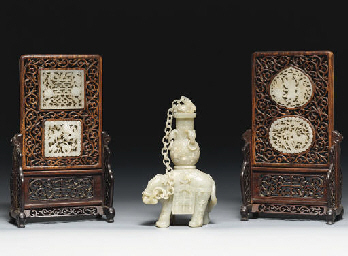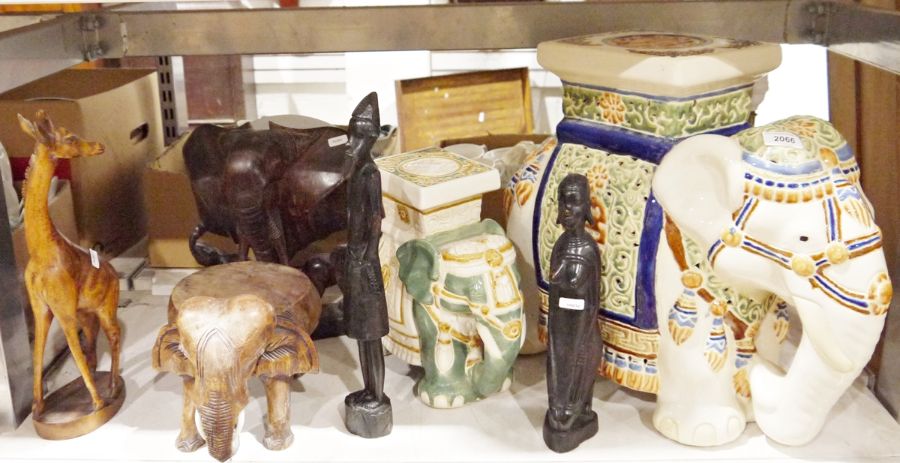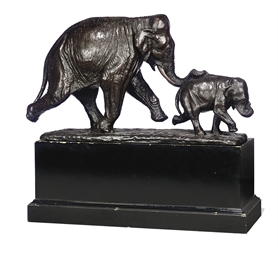An elephant and a unicorn fighting, on a cutting from an illustrated medieval manuscript [Italy (Bologna), c. 1300 (most probably last decades of the thirteenth century)] Cutting from the centre of the bas-de-page of a Bolognese manuscript (most probably a law codex, but perhaps a Bible: see below), containing the ends of two stylised sprays of coloured acanthus leaves in blue, red and pale yellow, all edged with white penwork, both sprays curling up in the centre of the fragment to form two roundels, those enclosing a rotund elephant on the left, with a large gold bell tied around his waist with a rope, followed by his mahout (an elephant keeper) who whips his rear with a three-ended crop, and a unicorn on the right, with its horn lowered and aimed at the elephants head, all on heavy white parchment with ivory sheen, reverse blank apart from nineteenth-century 70 in pen, with photocopy of clipping from sale catalogue (in fact that of Sothebys, 21 June 1988, lot 9, when this item last appeared at auction), some small spots and scuffs, but overall in excellent condition, loosely laid down on card with remnants of UK dealers marks, the cutting: 208 by 63 mm. Elephants and unicorns command the fascination of art lovers from the Ancient World to the present day, adding a sense of the opulent and faraway East. That said, they are of enormous rarity in medieval art, and generate excitement whenever they come to the market (see the Book of Hours sold in the Barilla sale at Sothebys, 14 March 2012, lot 45, which included a single marginal elephant on fol. 18r, and which made nearly £50,000 against an estimate of £20,000-30,000). The image here stands quite apart from the herd of its medieval peers, in that the elephant is not carrying a castle on its back or wrestling with a dragon, and the unicorn is not being trapped while resting in the lap of a maiden. The imagery here illustrates the story told by Isidore of Seville (Etymologies, book XII, 2: 12-13, and copied from there by numerous medieval bestiary writers; another similar illustration exists in the border of fol. 100v of the extra illustrated Queen Marys Psalter: British Library, Royal MS 2 B. vii) that the elephant and unicorn (monoceros in Isidores account) are natural enemies, the unicorn wounding the elephant by thrusting its sharp horn into the elephants soft underbelly. The tale has its ultimate origin in Roman misunderstandings of the supposedly violent nature of elephants and rhinoceroses (monoceros in Latin), and records survive of attempts to get these animals to fight each other in the Colosseum in Rome during the reign of Emperor Claudius. The lower margins of Bolognese law codices and Bibles produced in the last decades of the thirteenth century and the opening years of the fourteenth century are frequently inhabited by fantastical animals and battles (see the battle of naked men riding lions, fishermen lassoing dragons, lion hunts and a wolf and bull fighting, all at the foot of leaves of the late thirteenth-century Bolognese Bible once in the Major J.R. Abbey collection, discussed in Alexander and De La Mere, The Italian Manuscripts in the Library of Major J.R. Abbey, 1969, no. 4, pp. 12-19, the first scene illustrated pl. VII, opposite p. 28), but there may be more here than just medieval whimsy. The elephant here is accompanied by a mahout, who directs the beast with a three-ended crop. This finds parallels in only three other medieval images known to the present writer, all from thirteenth- or fourteenth-century England. The marginal painting of an elephant carrying musicians by Matthew Paris at the foot of fol. 151v of the Corpus Christi College, Cambridge, manuscript of his Chronica majora, shares much with that on fol. 87v in a near-contemporary bestiary (now part of Bodleian, Douce MS. 88; note similar realistic attachments of howdah), and the latter is probably directly influenced by the former. However, while a figure comically leans out of the back of
An elephant and a unicorn fighting, on a cutting from an illustrated medieval manuscript [Italy (Bologna), c. 1300 (most probably last decades of the thirteenth century)] Cutting from the centre of the bas-de-page of a Bolognese manuscript (most probably a law codex, but perhaps a Bible: see below), containing the ends of two stylised sprays of coloured acanthus leaves in blue, red and pale yellow, all edged with white penwork, both sprays curling up in the centre of the fragment to form two roundels, those enclosing a rotund elephant on the left, with a large gold bell tied around his waist with a rope, followed by his mahout (an elephant keeper) who whips his rear with a three-ended crop, and a unicorn on the right, with its horn lowered and aimed at the elephants head, all on heavy white parchment with ivory sheen, reverse blank apart from nineteenth-century 70 in pen, with photocopy of clipping from sale catalogue (in fact that of Sothebys, 21 June 1988, lot 9, when this item last appeared at auction), some small spots and scuffs, but overall in excellent condition, loosely laid down on card with remnants of UK dealers marks, the cutting: 208 by 63 mm. Elephants and unicorns command the fascination of art lovers from the Ancient World to the present day, adding a sense of the opulent and faraway East. That said, they are of enormous rarity in medieval art, and generate excitement whenever they come to the market (see the Book of Hours sold in the Barilla sale at Sothebys, 14 March 2012, lot 45, which included a single marginal elephant on fol. 18r, and which made nearly £50,000 against an estimate of £20,000-30,000). The image here stands quite apart from the herd of its medieval peers, in that the elephant is not carrying a castle on its back or wrestling with a dragon, and the unicorn is not being trapped while resting in the lap of a maiden. The imagery here illustrates the story told by Isidore of Seville (Etymologies, book XII, 2: 12-13, and copied from there by numerous medieval bestiary writers; another similar illustration exists in the border of fol. 100v of the extra illustrated Queen Marys Psalter: British Library, Royal MS 2 B. vii) that the elephant and unicorn (monoceros in Isidores account) are natural enemies, the unicorn wounding the elephant by thrusting its sharp horn into the elephants soft underbelly. The tale has its ultimate origin in Roman misunderstandings of the supposedly violent nature of elephants and rhinoceroses (monoceros in Latin), and records survive of attempts to get these animals to fight each other in the Colosseum in Rome during the reign of Emperor Claudius. The lower margins of Bolognese law codices and Bibles produced in the last decades of the thirteenth century and the opening years of the fourteenth century are frequently inhabited by fantastical animals and battles (see the battle of naked men riding lions, fishermen lassoing dragons, lion hunts and a wolf and bull fighting, all at the foot of leaves of the late thirteenth-century Bolognese Bible once in the Major J.R. Abbey collection, discussed in Alexander and De La Mere, The Italian Manuscripts in the Library of Major J.R. Abbey, 1969, no. 4, pp. 12-19, the first scene illustrated pl. VII, opposite p. 28), but there may be more here than just medieval whimsy. The elephant here is accompanied by a mahout, who directs the beast with a three-ended crop. This finds parallels in only three other medieval images known to the present writer, all from thirteenth- or fourteenth-century England. The marginal painting of an elephant carrying musicians by Matthew Paris at the foot of fol. 151v of the Corpus Christi College, Cambridge, manuscript of his Chronica majora, shares much with that on fol. 87v in a near-contemporary bestiary (now part of Bodleian, Douce MS. 88; note similar realistic attachments of howdah), and the latter is probably directly influenced by the former. However, while a figure comically leans out of the back of















Try LotSearch and its premium features for 7 days - without any costs!
Be notified automatically about new items in upcoming auctions.
Create an alert